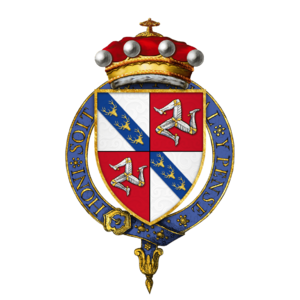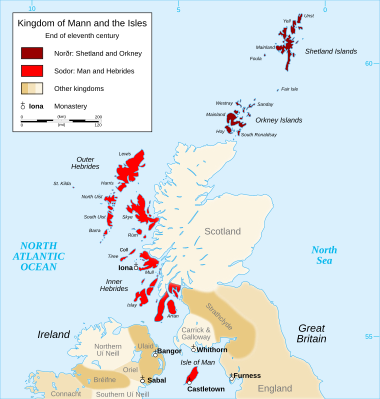King of Mann facts for kids
The King of Mann (in Manx Gaelic, Ree Vannin) was a special title used by the rulers of the Isle of Man between 1237 and 1504. The Isle of Man is a small island located in the Irish Sea, right in the middle of the British Isles. These rulers were sometimes fully independent (sovereign) and sometimes answered to a more powerful king (suzerain). After 1504, the ruler of the island became known as the Lord of Mann.

Contents
Early Rulers of Mann (before 836)
Before the Vikings arrived, the Isle of Man had its own rulers, often called kings, who were part of the Celtic traditions of the region. These early leaders helped shape the island's history.
- Tutagual Theodovellaunus (around 485–495)
- Dingat (around 495)
- Sennylt Hael (around 550)
- Neithon (around 575)
- Diwg (around 600s)
- Edwin of Northumbria (620–633)
- Merfyn Fawr (until around 682)
- Anarawd Gwalchcrwn (from around 682)
- Tudwal (around 710)
- Sandde (around 730)
- Elidyr (around 790)
- Gwriad (until 825)
- Merfyn Frych (825–844)
- Rhodri the Great (844–878)
- Anarawd ap Rhodri (878–around 900)
Kings of Mann and the Isles (836–1237)

During this time, the rulers of the Isle of Man also controlled many of the islands in the Hebrides (off the coast of Scotland). They were known as "King of the Isles." However, as new powerful families like Somerled's clan grew in the 12th century, the Manx kings started to lose control over some of these other islands. Later, the kings began to call themselves "King of Mann and the Isles," showing their focus was shifting more to the Isle of Man itself.
Under Norway's Influence (1237–1265)
For a period, the Kings of Mann and the Isles were like junior partners to the powerful Kings of Norway. This meant they ruled the island but had to show loyalty and sometimes pay tribute to the Norwegian king.
- Harald Olafsson (1237–1248)
- Ragnald Olafsson (1249)
- Harald Godredson (1249–1252)
- Magnus Olafsson (1252–1265)
Scottish and English Control (1265–1333)
Between 1265 and 1333, the Isle of Man was often fought over by Scotland and England. It was ruled directly by the kings of Scotland for some periods (1265–1290, 1293–1296, 1313–1317, 1328–1333) and by the kings of England at other times (1290–1293, 1296–1313, 1317–1328). This shows how important the island was for controlling the Irish Sea.
Independent Kingdom (1333–1399)

On August 9, 1333, King Edward III of England made a big decision. He officially gave up all claims to the Isle of Man and recognized it as an independent kingdom. At this time, the king of Mann was William Montacute, 1st Earl of Salisbury. This meant the Isle of Man was its own country, free from English rule.
The last King of Mann in this independent line was William le Scrope, 1st Earl of Wiltshire. He claimed to be related to the earlier Norse rulers of the island. However, William le Scrope was executed for going against King Richard II, who was later defeated by Henry Bolingbroke (who became King Henry IV). Because of this, William le Scrope's lands, including the Isle of Man, were taken by the English Crown.
Kings of Mann during this period
- William Montagu, 1st Earl of Salisbury (1333–1344)
- William Montagu, 2nd Earl of Salisbury (1344–1392)
- William Scrope, 1st Earl of Wiltshire (1392–1399)
Under English Influence (1399–1504)
When Henry IV became King of England, he didn't directly claim the title of King of Mann. Instead, he said he had taken the island by "right of conquest" because he had defeated William le Scrope. This meant he could decide what happened to the island.
On October 19, 1399, Henry IV gave the Isle of Man to Henry Percy, 1st Earl of Northumberland. He gave it as a "fiefdom," which means Percy would rule the island but still had to be loyal to the English Crown. Percy was given a lot of power to govern the island and was called 'Lord of Man,' but he still called himself 'King of Mann.'
Later, Henry Percy rebelled against King Henry IV. After this, in 1405, Henry IV gave the Isle of Man to Sir John Stanley. This time, the grant was for Sir John's lifetime. Sir John Stanley was also given control over the Diocese of Sodor and Man, which is the church on the island.
In 1406, a new agreement was made with Sir John Stanley. This time, the right to rule the Isle of Man could be passed down to his children. In return, the Stanley family had to show loyalty to all future English kings and give them a special gift: two falcons at every English king's coronation ceremony.
Kings of Mann during this period
- Henry, Earl of Northumberland (1399–1405)
- John Stanley (1405–1414)
- John Stanley (1414–1437)
- Thomas, Lord Stanley (1437–1459)
- Thomas, Earl of Derby (1459–1504)
Lord of Mann (1504–present)
Edward Stanley, 3rd Earl of Derby, who was the son of Thomas Stanley, 2nd Earl of Derby, decided not to use the title "King." Instead, he and the rulers who came after him were generally known as the Lord of Mann. Even so, sometimes in official Latin documents, the old title Rex Manniae et Insularum (King of Mann and the Isles) was still used until the 1600s.
In 1765, the title and rights to the Isle of Man were bought back by the the Crown of Great Britain. This was done through a law called the Isle of Man Purchase Act 1765. So, today, the title of Lord of Mann is held by the current British monarch, King Charles III.
See also
- History of the Isle of Man
- Noble and royal titles of the Isle of Man

